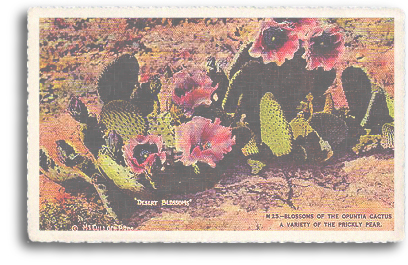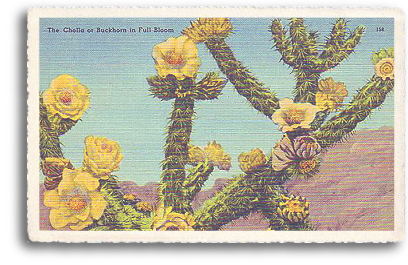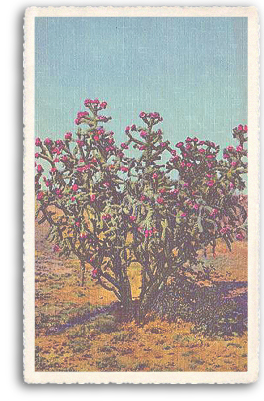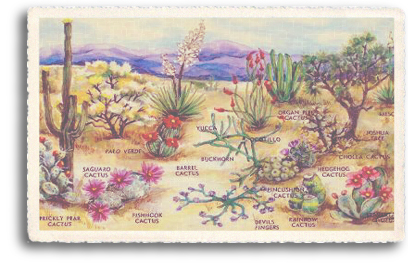 |
||
Cactus of the Northern New Mexico High Desert  Prickly Pear and Cholla Prickly Pear and ChollaPrickly Pear cacti (pictured top right) represent about a dozen species of the Opuntia genus (Family Cactaceae) in the North American deserts. All have flat, fleshy pads that look like large leaves. The pads are actually modified branches or stems that serve several functions: water storage, photosynthesis and flower production. Chollas (pictured right, 2 and 3) are also members of the Opuntia genus but have cylindrical, jointed stems rather than flat pads. Cholla cacti represent more than 20 species of the Opuntia genus in the North American deserts. Chollas are the only cactus with papery sheaths covering their spines. These sheaths are often bright and colorful, providing the cactus with its distinctive appearance. Opuntias (both Prickly Pear and Cholla) are usually fast-growing, take little care, and many are very hardy. These beautiful cacti are famous for their distinct character and are standouts as specimens. Some Opuntias are miniatures that span only inches, and are essentially ground covers, while others are arborescent tree forms ranging up to 20 feet in height.  Like other cacti, most Prickly Pears and Chollas have large spines (actually modified leaves) growing from tubercles (small, wart-like projections) on their stems. But members of the Opuntia genus are unique because of their clusters of fine, tiny, barbed spines called glochids. Found just above the cluster of regular spines, glochids are yellow or red in color and detach easily from the pads. Glochids are often difficult to see and more difficult to remove, once lodged in the skin. Like other cacti, most Prickly Pears and Chollas have large spines (actually modified leaves) growing from tubercles (small, wart-like projections) on their stems. But members of the Opuntia genus are unique because of their clusters of fine, tiny, barbed spines called glochids. Found just above the cluster of regular spines, glochids are yellow or red in color and detach easily from the pads. Glochids are often difficult to see and more difficult to remove, once lodged in the skin.The fruits of most Prickly Pear cactus are edible and sold in stores under the name "Tuna." Prickly Pear branches (the pads) are also cooked and eaten as a vegetable. They, too, are sold in stores under the name "Nopalito." Because of the glochids, great care is required when harvesting or preparing Prickly Pear cactus. Prickly Pear nectar is made with the juice and pulp of the fruits. Prickly Pear and Cholla cacti are found in all of the deserts of the American Southwest, with different species having adapted to different locals and elevation ranges. Most require course, well-drained soil in dry, rocky flats or slopes. But some prefer mountain pinon-juniper forests, while others require steep, rocky slopes in mountain foothills.  Most Prickly Pear cactus have yellow, red or purple flowers, even among the same species. They vary in height from less than a foot to 6 or 7 feet. Pads can vary in width, length, shape and color. Most Prickly Pear cactus have yellow, red or purple flowers, even among the same species. They vary in height from less than a foot to 6 or 7 feet. Pads can vary in width, length, shape and color.Most Cholla cactus have orange or greenish-yellow flowers with a variety of colors. Most species bloom April through June, depending on local conditions. Stems and joints vary in width, length, shape, and color, as well as in the profusion of spines and glochids. Chollas may appear as ground creepers, shrubs or trees, varying in height from less than a foot to as tall as 15 feet. There has been medical interest in the Prickly Pear plant. Some studies have shown that the pectin contained in the Prickly Pear pulp lowers levels of "bad" cholesterol while leaving "good" cholesterol levels unchanged. Another study found that the fibrous pectin in the fruit may lowers a diabetic’s need for insulin. Both fruits and pads of the Prickly Pear cactus are rich in slowly absorbed soluble fibers that help keep blood sugar stable. There are on going studies and at this point there are no proven results on humans. Many types of Prickly Pear cactus can grow into dense, tangled structures. They are the most cold-tolerant of the cacti, extending into northern Canada. Some General Facts About Cactus All cacti are succulents, but not all succulents are cacti. What separates a cactus from a succulent is the organs that produce the spines, and some other characteristics specific to fruit formation. Many of the smaller cactus that live in a desert environment are situated under bushes or in behind rocks and do not receive constant, intense sunlight. The native habitat of many other cacti is often at a higher altitude (where the light is strong but the temperatures are far cooler than on the desert floor), or in tropical jungle-like environments. Many cactus dwell at higher altitudes and underneath pine trees, where they receive very little direct sun.  All cacti need a rapidly draining, porous soil mix. If kept fairly dry, most cactus can tolerate without difficulty night-time temperatures which are consistently as low as 32 degrees. Cacti have a thick, hard-walled, succulent stem. When it rains, water is stored in the stem. The stems are photosynthetic, green, and fleshy. The inside of the stem is either spongy or hollow (depending on the cactus). A thick, waxy coating keeps the water inside the cactus from evaporating. Many cactus can also be grown from broken-off parts of the plan, but the new plant will be genetically identical to the original plant. Pictured bottom right are some of the other types of cactus that can be found in the deserts of the Southwest. Back to Plants & Wildlife |
||
Home | Food | Lodging | Merchants | Services | Real Estate | Art & Galleries | Entertainment | Recreation Ski Areas | Mind-Body-Spirit | Taos Information | Local Color | Taos Pueblo | High Road to Taos | Taos Plaza | Ranchos de Taos Scenic Beauty | Day Trips | Chili | Special Events | Taos History | Multicultures | Museums | The Enchanted Circle The Wild West | Taos Art Colony | Plants & Wildlife | Counterculture | Turquoise | Architecture | Features | About Us | Get Listed! Taos Unlimited Trading Post | Photo of the Week | Link of the Month | Taos Webcams | Taos Weather | Testimonials | Guestbook Taos A to Z | Movie Locations | Sitemap | Taos Unlimited Blog | Aimee & Jean's Story Blog | Contact Us | Santa Fe Unlimited |
||